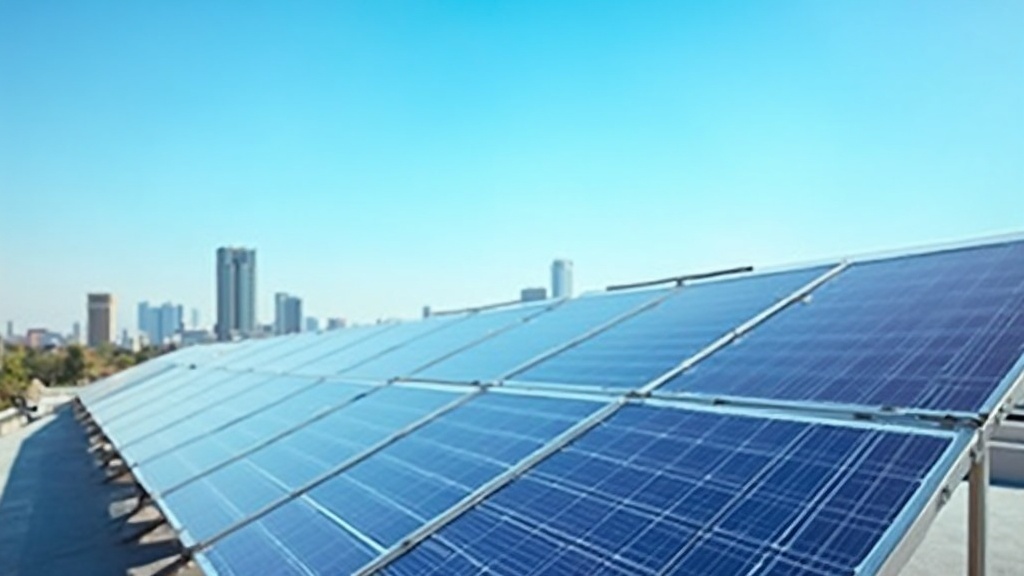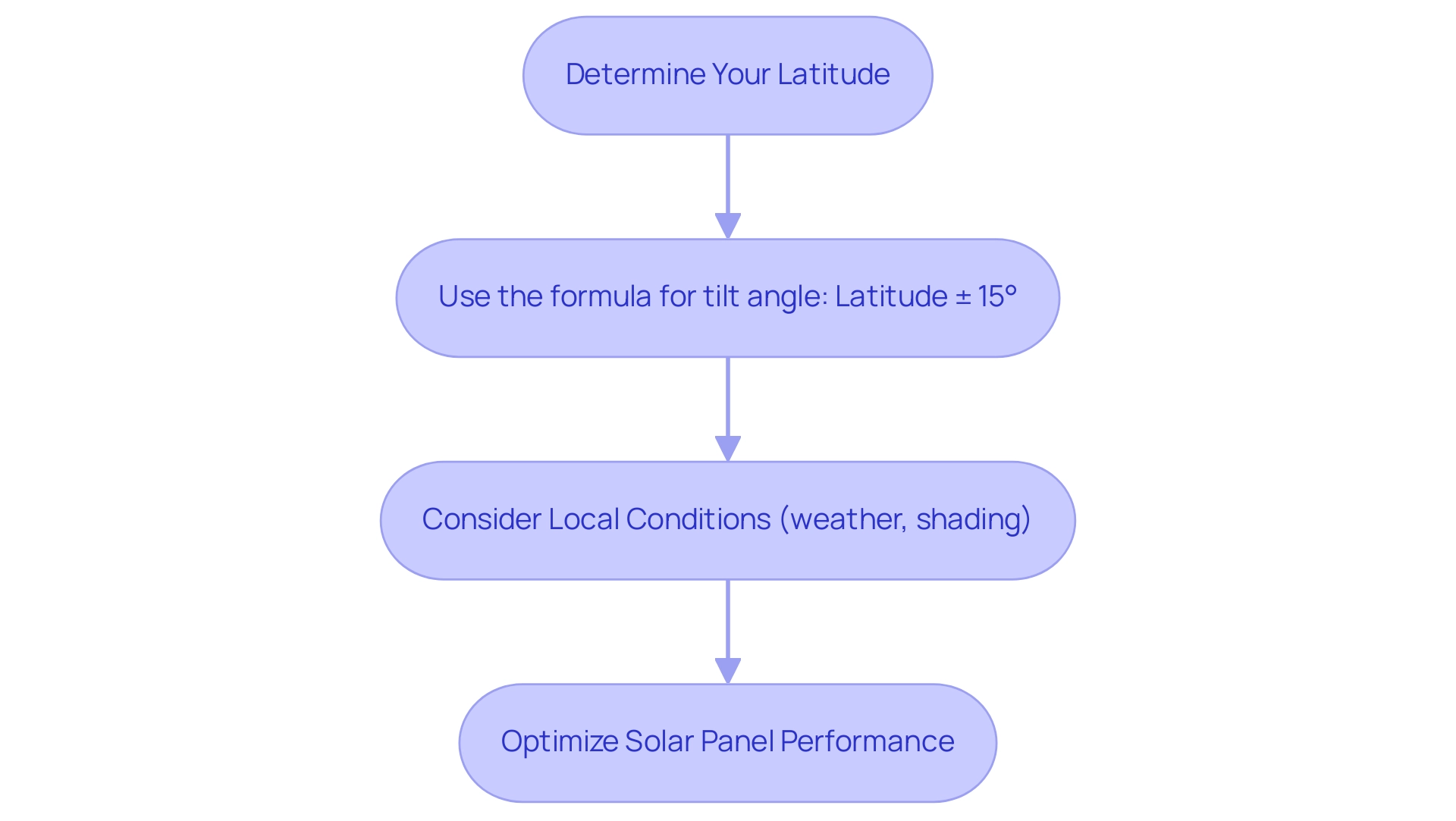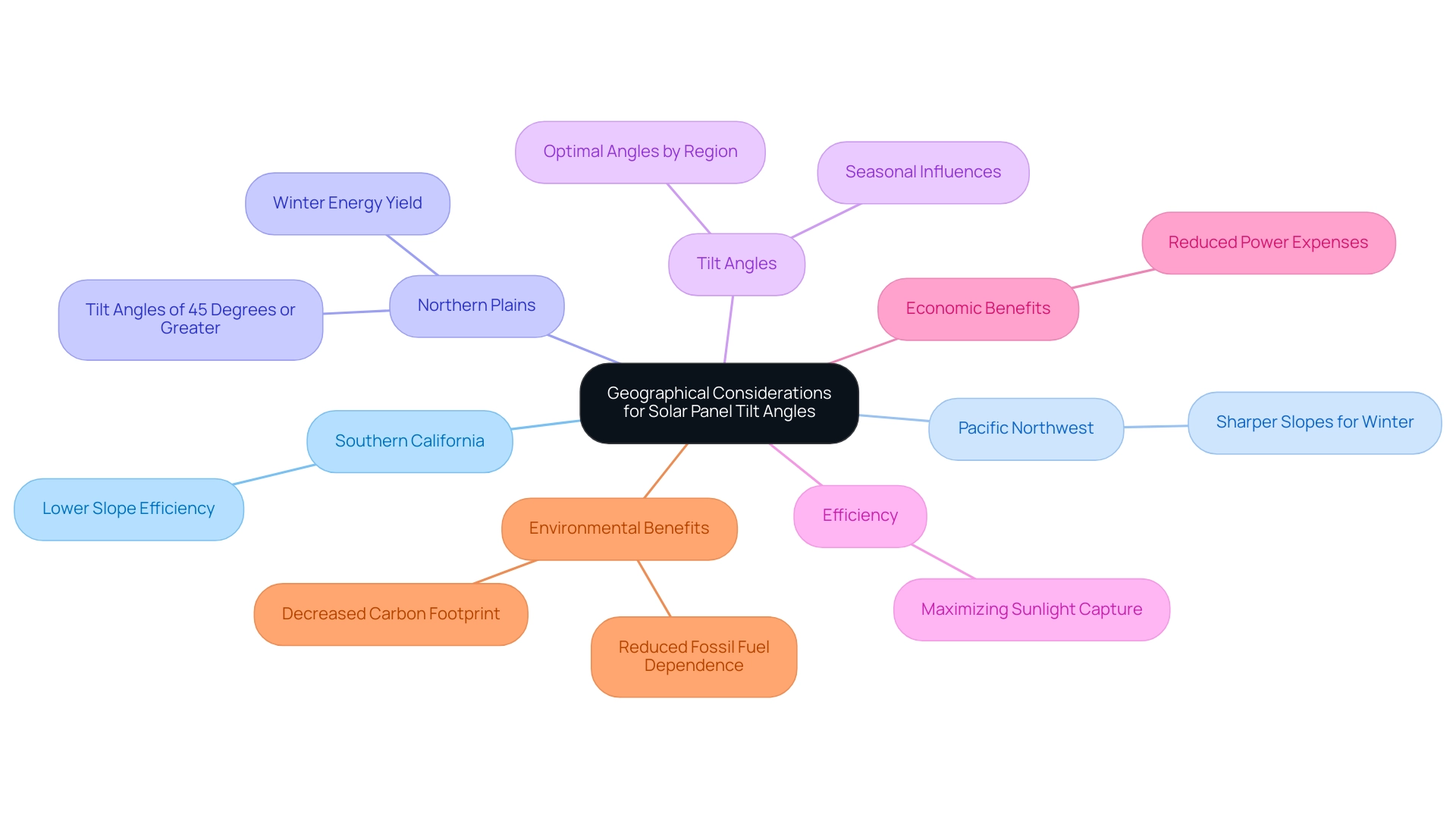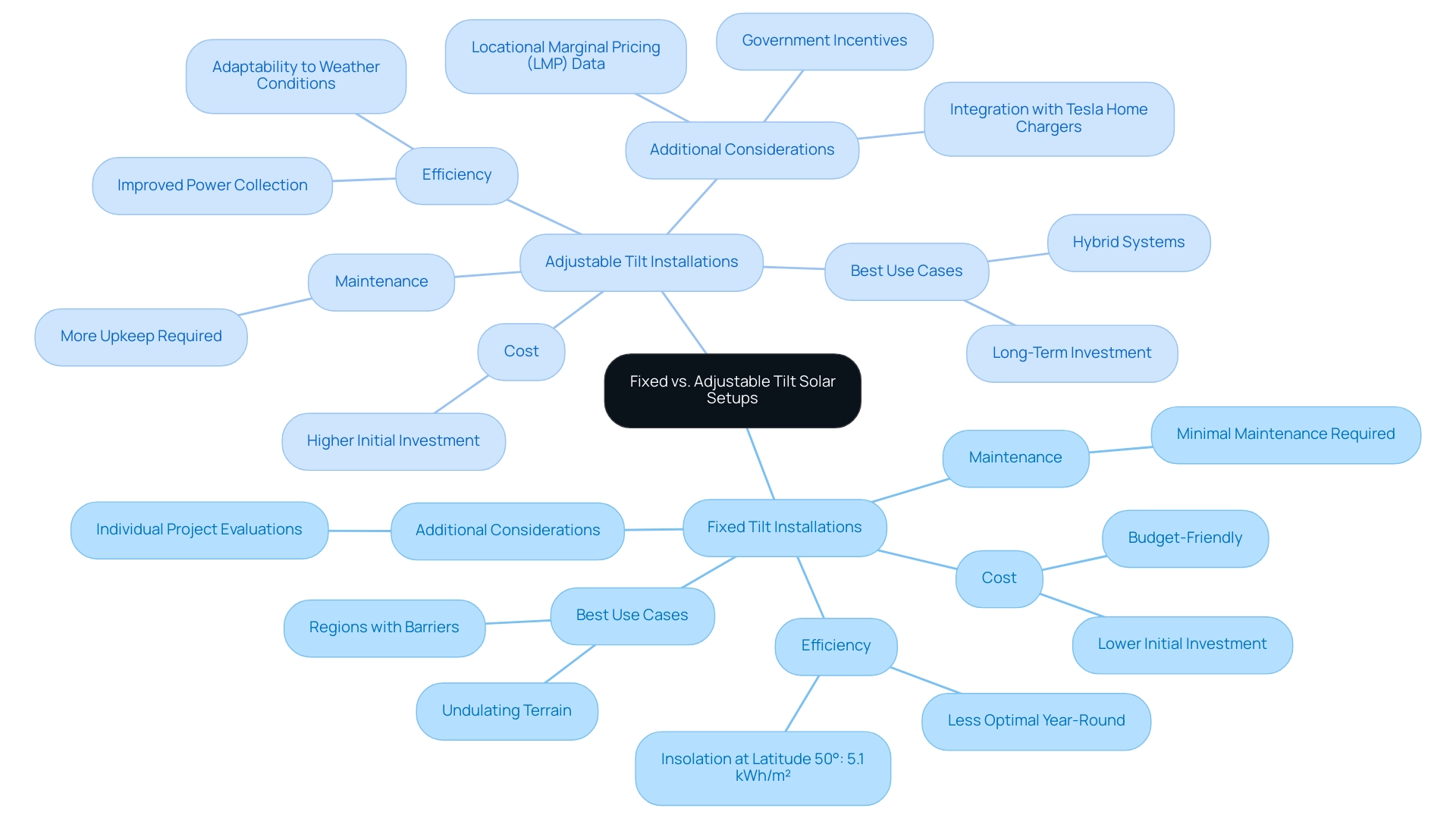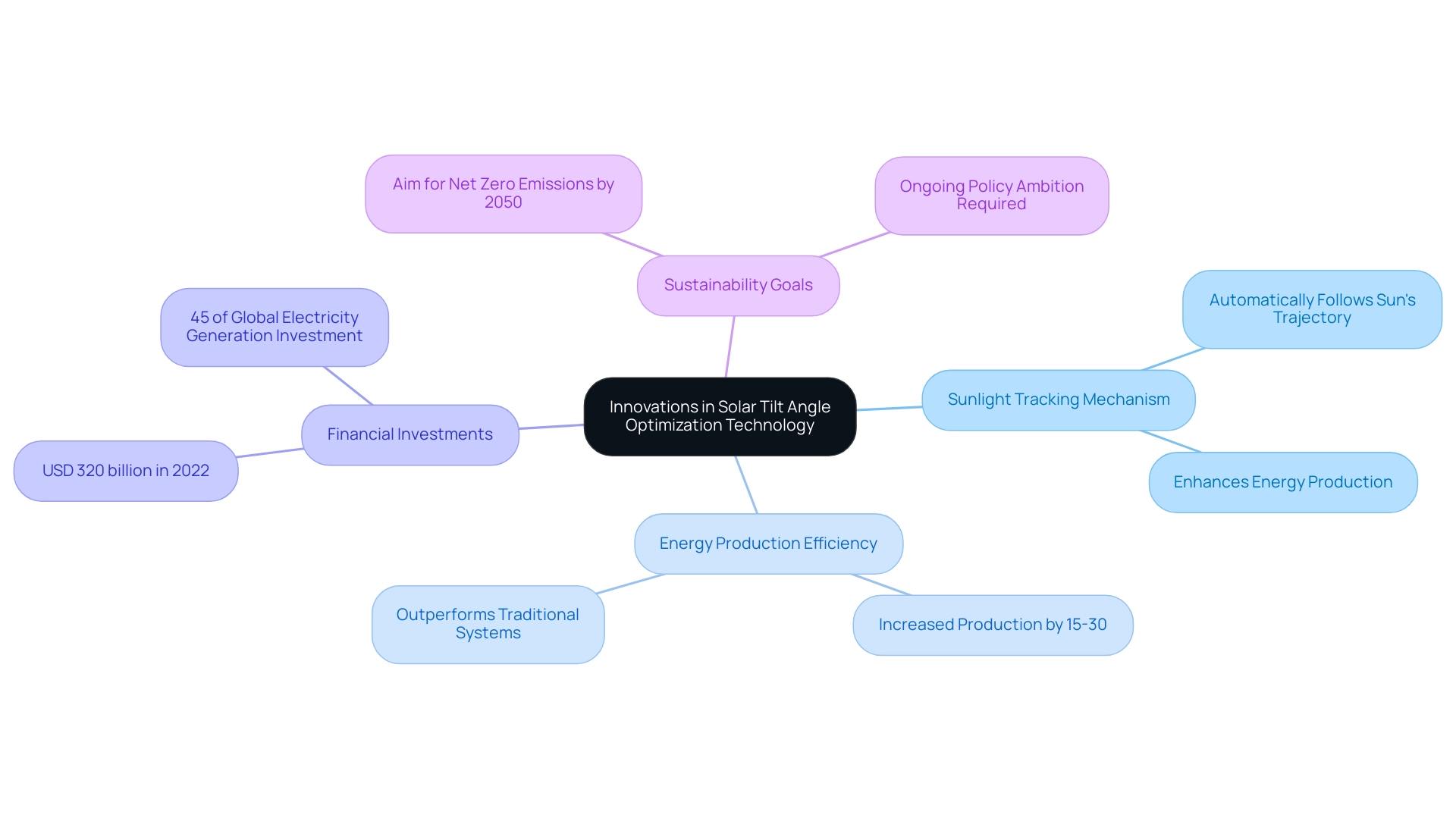Overview
To determine the optimal solar tilt angle for photovoltaic panels, one must consider geographic location, seasonal changes, and household energy needs, with a common approach being to set the angle equal to the latitude for year-round efficiency. The article supports this by detailing how proper adjustments can enhance solar energy capture by 10-15% and even more with advanced tracking technologies, ultimately leading to significant energy cost savings and environmental benefits.
Introduction
Understanding how to maximize solar energy efficiency can feel overwhelming, but it all starts with one key factor: the tilt angle of your solar panels. This seemingly simple adjustment can dramatically influence how much sunlight your panels capture, ultimately affecting your energy production and savings.
Whether you’re a seasoned solar enthusiast or just beginning to explore renewable energy options, grasping the importance of tilt angles is crucial for optimizing your system. From geographical considerations to the latest innovations in solar technology, this article will guide homeowners through the essential steps to ensure their solar panels are positioned for peak performance, paving the way for a more sustainable and cost-effective energy solution.
Understanding the Importance of Solar Panel Tilt Angle
The solar tilt angle of your photovoltaic panels is crucial for effectively capturing the sun’s power. When placed properly, a solar panel can capture a greater amount of sunlight, significantly enhancing power production. The optimal solar tilt angle is influenced by several factors, including your geographic location, the season, and your household’s specific power needs.
Recent research, including one that created a simplified mathematical model for solar power generation, has demonstrated that the solar tilt angle directly influences monthly electrical output, achieving a Coefficient of Determination of 0.9314. This research highlights how even slight adjustments can lead to improved efficiency. For instance, a solar tilt angle of 20 degrees can enhance output by approximately 10% to 15%.
As one user noted from their testing, a well-aimed panel can yield significant efficiency gains, with a properly matched power curve potentially increasing output by 30% or more. Furthermore, as emphasized by new advancements in the renewable energy sector, modeling software such as RatedPower offers customized recommendations for the solar tilt angle based on latitude, ensuring your setup functions at optimal performance. By understanding the significance of the solar tilt angle and the supporting research, you can enhance your energy system to not only reduce energy costs—potentially hundreds of dollars each year (between $400 to $600)—but also make a considerable stride toward a sustainable future.
Utilizing heating systems powered by the sun can prevent approximately 2 tons of carbon dioxide from entering the atmosphere each year, contributing to a healthier planet.
Calculating the Optimal Tilt Angle for Maximum Efficiency
Determining the optimal solar tilt angle for your solar panels is a straightforward yet essential process that can significantly enhance their efficiency and overall performance. Here’s how to get started:
-
Determine Your Latitude: First, find your geographical latitude using an online tool or a map.
This is vital because the orientation at which your panels are placed can significantly affect their power collection.
-
Use the formula: a commonly accepted method is to set your solar tilt angle equal to your latitude for year-round performance.
For seasonal adjustments, fine-tune this by adding or subtracting 15 degrees—higher in winter to catch the lower sun and lower in summer for the higher sun.
-
Consider Local Conditions: Take into account local weather patterns and any shading from trees or buildings.
This simple adjustment can ensure your panels capture the maximum sunlight throughout the year.
Research shows that at a latitude of 50° with a tilt of 68.5°, the summer insolation reaches an impressive 5.1 kWh/m². Remarkably, Sharma M. K. emphasizes that adjusting the position can boost yearly power production by 7–8%, improving efficiency and aiding in the reduction of carbon emissions.
Moreover, research by Tijani H., Aissaoui A., and Younes R. B. supports the significance of the solar tilt angle in optimizing sunlight capture. Additionally, the Koppen-Geiger-Photovoltaic methodology underscores the significance of climate conditions in evaluating panel performance.
By customizing the angle of your panels, you’re not only guaranteeing enhanced savings for your home but also making a positive impact on the environment, particularly as a Long Beach renter seeking eco-friendly power solutions.
Moreover, when assessing renewable power solutions, it’s crucial to examine the top battery options for effective power storage. Options like the Tesla Powerwall provide excellent performance and compatibility with energy systems, ensuring that you can store excess energy generated during the day for use at night or during cloudy periods. Investigating available government programs can also offer financial incentives and assistance for your installation, making it a more accessible option for homeowners in Long Beach.
Geographical Considerations for Solar Panel Tilt Angles
When it involves photovoltaic panel setup, your geographical position is a crucial factor in determining the ideal solar tilt angle. For environmentally aware homeowners in sunny Southern California, a lower slope can improve efficiency throughout the year, while those in the Pacific Northwest might gain from sharper slopes to collect valuable sunlight, particularly during winter months. Seasonal variations significantly influence sunlight capture, and comprehending this is essential for maximizing efficiency.
For example, case studies have demonstrated that states in the Northern Plains, like North Dakota and Minnesota, need tilt angles of 45 degrees or greater to maximize output in winter, considering that at latitude 50°, the insolation in summer is 5.1 kWh/m². Furthermore, the economic advantages of heating systems utilizing sunlight are significant, as they can greatly decrease power expenses over time, while the environmental benefits encompass a decrease in carbon footprint and dependence on fossil fuels. Factors like roof orientation and aesthetics should guide your panel direction.
Working alongside expert installers can offer priceless perspectives customized to your unique area, ensuring you maximize the full potential of renewable resources while taking into account these financial and ecological benefits. Always keep local climate conditions and sunlight exposure in mind when determining your tilt angle, as these factors will significantly influence your panel’s efficiency and long-term sustainability.
Fixed vs. Adjustable Tilt: Which is Better for Your Solar Setup?
When evaluating the choices between fixed and adjustable tilt energy panel setups, it’s crucial to take into account the solar tilt angle, as it can significantly influence your energy efficiency and total contentment. Additionally, grasping the wider context of solar options can improve your decision-making.
- Fixed Tilt Installations: These straightforward setups require minimal maintenance and tend to be budget-friendly, making them appealing for many homeowners. However, they may not capture sunlight as effectively throughout the year compared to adjustable setups that optimize the solar tilt angle. For instance, at latitude 50°, the summer insolation can reach 5.1 kWh/m², but a fixed setup may not optimize the solar tilt angle to take full advantage of that potential. In regions with rolling landscape or barriers that limit panel movement, fixed-tilt installations could be more appropriate, necessitating individual project evaluations to identify the optimal method.
- Adjustable Tilt Installations: These setups provide the adaptability to modify the solar tilt angle of your panels throughout the seasons, greatly improving power collection during the year. While the initial investment might be higher and they demand more upkeep, the potential for increased efficiency—especially in varying weather conditions—can make this investment worthwhile. Gabrielė Ptašinskaitė-Mačiulė emphasizes understanding Locational Marginal Pricing (LMP) data to forecast profitability and minimize financial risk, suggesting that adjustable frameworks could be a wise long-term choice. Significantly, a case analysis named ‘Efficient DC Grid Based PV-Wind Power Generation’ demonstrates how hybrid setups enhance power extraction under different conditions, backing the argument for adaptable arrangements.
Regarding expenses, photovoltaic solutions frequently offer a more advantageous long-term financial perspective compared to conventional electricity, particularly when considering government incentives and possible savings on utility bills. Moreover, incorporating Tesla home chargers into your renewable system can further improve efficiency and cost reductions. It’s also essential to consider panel cleaning services and battery alternatives, which can greatly influence the overall efficiency of your energy setup.
Ultimately, your choice should depend on personal factors—such as your power requirements, budget constraints, and readiness for maintenance. By thoroughly assessing these factors, including the effectiveness data that indicate how the solar tilt angle in adjustable setups can surpass fixed setups in ideal circumstances, you can select a panel arrangement that aligns with your eco-friendly objectives and optimizes your home’s power potential.
Innovations in Solar Tilt Angle Optimization Technology
Thrilling progress in optimizing the tilt position of photovoltaic setups is enhancing renewable power solutions like never before. One remarkable advancement is the sunlight tracking mechanism, which automatically modifies the position of your panels to follow the sun’s trajectory throughout the day. To enhance power generation, photovoltaic panels should ideally be positioned at the solar tilt angle that matches the latitude of your area, adjusted seasonally for optimal performance.
This clever technology can enhance energy production by an impressive 15–30% compared to traditional fixed setups, allowing for greater clean energy generation. Furthermore, as investments in global photovoltaic systems surpassed USD 320 billion in 2022, it underscores the growing financial backing for these technologies. Advancements such as tracking technologies for sunlight are essential as we aim to achieve Net Zero Emissions by 2050, backed by continuous policy goals.
Numerous contemporary setups come equipped with intelligent technology, allowing you to oversee and modify your photovoltaic panels from a distance using user-friendly mobile applications. By integrating these advanced solutions, you’re not only improving the efficiency of your renewable power setup but also aiding in a more sustainable future. Additionally, when comparing solar heating systems, those with optimized solar tilt angles and advanced tracking can significantly outperform traditional systems, leading to substantial cost savings on utility bills and reductions in greenhouse gas emissions.
This further emphasizes the importance of these technologies in promoting sustainability and energy independence.
Conclusion
Maximizing the efficiency of solar panels through the correct tilt angle is essential for homeowners looking to harness the full potential of solar energy. This article has explored how the tilt angle directly impacts energy production, with studies indicating that even minor adjustments can lead to substantial efficiency gains. Understanding geographical factors, seasonal variations, and the specific energy needs of a household are crucial for determining the optimal angle for solar panels.
The choice between fixed and adjustable tilt systems also plays a significant role in overall performance. While fixed systems are easier to maintain and more budget-friendly, adjustable systems offer greater flexibility and can significantly enhance energy capture throughout the year. Innovations in solar technology, such as solar tracking systems, further demonstrate how modern solutions can optimize energy production and contribute to sustainability efforts.
In conclusion, by taking the time to analyze and adjust the tilt angle of solar panels, homeowners can not only increase their energy savings but also make a meaningful impact on the environment. Embracing these practices paves the way toward a more sustainable future, as each step taken in optimizing solar energy usage contributes to reducing carbon footprints and promoting energy independence. With the right knowledge and tools, anyone can transform their home into a more efficient and eco-friendly space.


